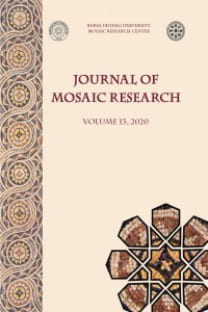Roma Mozaiğinin İkonografik Konularının Seçiminde Sanatın Hıristiyanlaştırılması; Praeparatio Euangelica Kavramı
Yukarıda adı geçen Latince deyim, çok tanrılı dinden Hıristiyanlığa giden yolun “ex machina”dan değil, aynızamanda çok tanrılı dinlerde süreklilik gösteren dindarlık deneyiminden geçtiğini ifade etmektedir. Evangelistolduğu söylenen bir oluşum küçük küçük ve pek çok yolla Hıristiyan vahiylerini, tüm Roma İmparatorluğu’naulaştırmaktadır. Bu klasik sanatın evriminde, özellikle en iyi örnekleri mozaik sanatında, diğer anlamlı mitlerinarasında bilhassa Orpheus’un hikayesinde görülebilir. Dolayısıyla klasik mitlere yeni yaklaşımların önemi,yani “opus musivum’da” temsil edilmeleri ele alınacaktır.
Anahtar Kelimeler:
Roma sanatı, mozaik, “praeparatio euangelica”, Paleo-Hıristiyan sanatı
From the Concept of Praeparatio Euangelica to the Christianization of Art, Especially in the Choice of Iconographic Subjects of the Roman Mosaic
As the Latin phrase in the above title says, the passage from paganism to Christianity does not arise ex machina,but it is also prepared through the continuous experience of religiosity in pagan contexts. There is a preparationthat is said to be evangelical, because little by little and in many ways, the Christian Good News reachesthe whole Roman Empire. This is visible in the evolution of classical art, especially in the mosaic, with the bestexamples, among other significant myths, of Orpheus’s story. Hence the importance of new approaches to classicalmyths, namely in their representation in opus musivum.
Keywords:
Roman art, mosaic, “praeparatio euangelica”, Paleo-Christian art,
___
- M. F. Abraços, 2005, Para a História da Conservação e Restauro do Mosaico Romano em Portugal, PhD Thesis, University of Lisbon, Lisboa.
- J. Alarcão, 1988, O Domínio Romano em Portugal, Paperback, Publicações Europa-América, Lisboa.
- J. M. Bairrão Oleiro, 1992, Conimbriga, Casa dos Repuxos in Corpus dos Mosaicos Romanos de Portugal. Conventus Scallabitanus. I+II, Conímbriga.
- M. J. Duran Kremer, 1999, Die Mosaïken der villa Cardilio (Torres Novas, Portugal). Ihre Einordnung in die musivische Landschaft der Hispania im allgemeinen und der Lusitania im besonderen, PhD Thesis, University of Trier, Trier.
- J. Lancha – P. André, 2000, A villa romana de Torre de Palma in Corpus dos Mosaicos Romanos de Portugal, Conventus Pacensis 1, I+II. Lisboa.
- J. Lancha – C. Oliveira, 2013, Algarve Este in Corpus dos Mosaicos Romanos de Portugal, Conventus Pacensis 2, Faro.
- A. M. Manière-Lévêque, 2012, Xanthos, Part 2, The West Area, Corpus of the Mosaics of Turkey II, Lycia, İstanbul, Ege Yayınları.
- M. P. Raynaud, 2009, Xanthos, Part 1, The East Basilica, Corpus of the Mosaics of Turkey I, Lycia, İstanbul, Ege Yayınları.
- H. Stern, 1955, “La mosaïque d’Orphée de Blanzy-lès-Fismes (Aisne)”, Gallia 13-1, 41-77.
- ISSN: 1309-047X
- Başlangıç: 2008
- Yayıncı: Ululdağ Üniversitesi, Mozaik Araştırlmaları Merkezi
Sayıdaki Diğer Makaleler
António Manuel de Carvalho LIMA
Baetica’daki Geometrik Mozaikler
Algarve’daki (Portekiz) Mozaikler ve Roma Resimleri Üzerindeki Figüratif Unsurlar
Conventus Pacensis Villalarındaki Geometrik Motifler
Roma: İÖ 2. yüzyıl’da Ekonomik Değişim - Lüks Bir Ürün Olarak Mozaik Konteksti
Augusta Emerita’nın (Merida) Mozaik Üretimi
Batı Roma Lusitania Epigrafik Anıtlar Üzerinde Doğudan Yansımalar
Kırsal Kentler: Lusitania Villaları’nda Dekoratif Programlar ve Mimari Modeller
Penela, Portekiz’de Yer Alan São Simão Roma Villası’ndan Mozaikler
